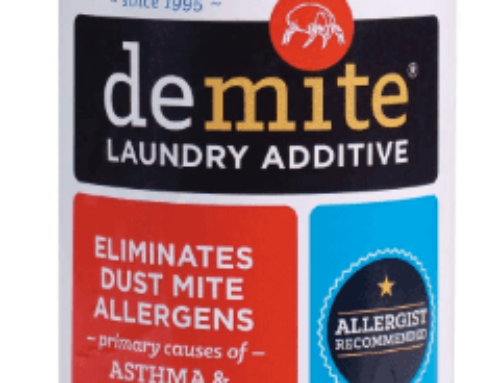Table of Contents
When you’ve had enough of sneezing and teary eyes, you start suspecting that the source of the allergen may be right under your feet. But how do you know if you have dust mites at home? Or if the cause of your allergies is due to something else?
That’s one of the questions that popped up my troubled mind when my son was having weeks of red eyes, itchy throat and eventually followed by a nasal block. As dust mites are invisible by the naked, you can’t be sure that these microscopic creatures are breeding in your home and causing havoc to your health.
The only way to be truly certain of dust mites’ presence is to invest in a digital microscope and inspect samples acquired from various parts of your home. Of course, you can also get the samples inspected with the available test kits.
But before you spend your hard-earned money, look out for clues for dust mites in your home.
Habitat That Dust Mites Thrive In
However, the habitat of dust mites is well-documented. These pests grow optimally in an environment that has a temperature between 20 °C – 25 °C (68°F – 77°F) and humidity of 70%-80%. The food source of dust mites is the millions of dead skin cells shed by humans daily.
It isn’t difficult to have an environment that fulfills these criteria unless you’re staying in the freezing winter or the sweltering desert. According to the American Lung Association, about four in five households have dust mites. That’s about 80%.
Does Everyone Have Dust Mites In Their Home?
Unless you got a dust mite test kit, or observed a sample with a microscope, you can’t conclusively confirm the presence of dust mites.
However, dust mites are more common than most people realized. If your home is considerably humid (look for signs of mold) and is between 68°F – 77°F, it’s likely to have dust mites.
So, it’s fair to say that every home that fulfills the environmental criteria may have dust mites, it has been abandoned for quite some time.
The reason why some people are not aware of the presence of the little pests is that they are not sensitive to the allergen. A high amount of allergen is needed before those lucky few starts getting mild symptoms.
Common Signs That You Have Dust Mites In Your Home
Chances are, dust mites are having a blast in your home, even if it looks spotlessly clean. A single mite is smaller than the pixel on your screen, which means it’s impossible to spot any of them lingering on the carpet or mattress.
However, there are tell-tale signs that your home may be infested with dust mites.
1. Mold And Mildew In Your Home
One of the giveaways for dust mites is the presence of mold and mildew. These fungi are a sign that the humidity in your home has exceeded the ideal range for humans, which falls around 45% – 55%.
If much of your walls or ceilings are covered with mold and mildew, the humidity in your home is at least 75%. The over-concentrated of moisture in the air is also fitting for dust mites. To be sure, get a hygrometer and take the relative humidity reading.
2. Allergy Symptom Persists Even When You’ve Close The Windows
When you’re having bouts of sneezing or irritated eyes, the common suspicion is the fine dust that enters your house. This can be true if you’re staying in a city where the air quality suffers from carbon emission and other forms of pollution.
Naturally, you’ll close every single window in your home and hope that the allergy will go away. That’s exactly what I did. If you have dust mites in your home, closing the window does nothing to the allergy. In some cases, you’ll find the symptoms aggravate as the poor ventilation increases the humidity in your home.
3. Cleaning Is Not Your Favorite Past Time
Prior to my son’s having dust mites allergy, cleaning is the last thing on my todo list. If your cleaning schedule is about once per month, you risk having piles of dead skin cells accumulating all over the house.
Common suspects are the carpets and beddings, where you spent most of the time sleeping. Even if they look spotlessly clean, the tiny dust mites could be having a feast with the millions of skin flakes. If you hate cleaning, be prepared for the possibility of dust mites having a field day at home.
Preventing Dust Mites Growth In Your Home

Most people are oblivious to the presence of dust mites in their homes, as they are not displaying allergy symptoms. However, if you’re one of the few who are highly sensitive to dust mites or the population of dust mites is so bad that it exceeds your tolerance level, you’ll need to take proactive steps to keep their numbers down.
It’s essential that you seek medical treatment for the symptoms you’re suffering, but without prevention measures, you’re likely to suffer a relapse when the medicine wears off.
Here are some helpful strategies to keep dust mites away from your home.
1. Kill The Dust Mites
Obviously, the first thing you ought to do with dust mites infestation is to kill them off. While dust mites are harmless by themselves, the protein found in their droppings is the source of your allergy. Bring down the dust mites and you’ll have less fecal pellets triggering your allergy.
There are a few ways to kill dust times, although the lethality of the methods varies. Apparently, using heat is the most efficient way to kill dust mites. Blasting a hot vapor from a steam cleaner instantly kills dust mites in the carpet.
The mattress often has the highest concentration of dust mites and arming yourself with equipment like a handheld steam cleaner or a UV vacuum helps in battling the pest. You could also spray essential oils like clove or eucalyptus to get rid of the mites.
Some of the dust mites may linger on the surface of the mattress. Washing the mattress covers, pillowcases and other beddings with hot water help to eliminate the pests.
2. Make Cleaning A Habit
The reality about dust mites is that you can’t hope to keep them out forever with a few blasts of steam. If you’ve found out that you’re allergic to dust mites, you need to increase the frequency of cleaning your home. There are just no two ways about it.
I stepped up to cleaning the beddings at least once a week when my child’s allergies are at its worst. There are some special detergents that you can use to get rid of dust mites in the laundry without harming the fabric.
You’ll want to spend time cleaning the carpets, upholsteries, and areas that trap dust easily. Often, dead skin flakes are mixed with the dust particle, which becomes food for dust mites. The task is made easier if you have a HEPA filter vacuum cleaner.
3. Disrupt Dust Mites Habitat
An ideal environment for dust mites isn’t healthy for humans and vice versa. Therefore, there are many incentives to disrupt the nice little habitat for dust mites in your home. You can start by ensuring your home is properly ventilated to bring down the humidity.
The easiest way is to ensure the windows are open so that the natural breeze will carry excessive air moisture out. Alternatively, it helps to bring in a dehumidifier as it helps to regulate home humidity to a desirable level.
Moisture is often trapped in mattress, which means making your bed the moment you woke up is a bad idea. Rather, you should remove the blanket or comforter for the moisture to dry out to prevent dust mites from breeding in the bed.
Personally, I’ve changed all the mattresses in the house to hypoallergenic ones, as doing so decreases the chances of dust mites growth in the bedroom. Replacing mattresses can be expensive. In such cases, you can put on mattress toppers that block dust mites.
Bottom Line
It’s hard to imagine how destructive dust mites can be until they start tearing your health apart. Seek medical treatment if you’re showing allergies symptoms. Look out for signs that point to dust mites infestation in your home and start getting rid of them with a disciplined routine.




Kenny,
Thanks for lots of info. I was really suprised to learn that 4 out of 5 households have dust mites.
I will never look at my mattress or carpet the same way again after reading your article! i will be deep cleaning both as frequently as possible.
I am however more worried about my mattress. The hypoallegenic mattress seems like a viable option, What precentage protection would such a mattress provide me from these annoying critters? Thanks
Hi Ceci,
Most people are oblivious with dust mites because they don’t suffer from allergies.
Hypoallergenic mattresses prevent dust mites from burrowing through it. However, they may still linger on the surface. You’ll still need to clean the beddings and vacuum the surface to prevent the mites from building up.
Cheers,
Kenny